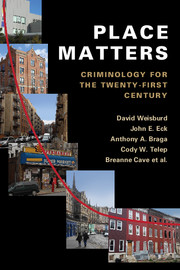Book contents
- Frontmatter
- Contents
- List of figures
- List of tables
- List of contributors
- Preface
- 1 Crime Places within Criminological Thought
- 2 The Concentration of Crime at Place
- 3 Theories of Crime and Place
- 4 The Importance of Place in Mainstream Criminology and Related Fields: Influences and Lessons to be Learned
- 5 Methods of Place-Based Research
- 6 Reducing Crime at High-Crime Places: Practice and Evidence
- 7 Crime Places in the Criminological Imagination
- Notes
- References
- Index
5 - Methods of Place-Based Research
Published online by Cambridge University Press: 05 April 2016
- Frontmatter
- Contents
- List of figures
- List of tables
- List of contributors
- Preface
- 1 Crime Places within Criminological Thought
- 2 The Concentration of Crime at Place
- 3 Theories of Crime and Place
- 4 The Importance of Place in Mainstream Criminology and Related Fields: Influences and Lessons to be Learned
- 5 Methods of Place-Based Research
- 6 Reducing Crime at High-Crime Places: Practice and Evidence
- 7 Crime Places in the Criminological Imagination
- Notes
- References
- Index
Summary
The growth of interest in the criminology of place has generated key developments in the data and methods used in identifying and understanding geographic concentrations of crime. Ron Clarke noted in 2004 that “quite soon, crime mapping will become as much an essential tool of criminological research as statistical analysis is at present” (Clarke 2004, 60). This means, of course, that criminologists will have to develop methods of analysis that meet the new problems that geographic data present. Moreover, with ever-improving data quality and resolution, there is a constant need to evolve better research methods, practices, and statistical approaches.
This chapter will outline the imperative for a robust analytical framework that incorporates measures of adjacency in any spatial analysis, and articulate the problems that can befall an aspatial approach to geographic data. The chapter then identifies some of the unique characteristics of spatial analysis before providing an overview of new and innovative approaches to spatial criminological research.
THE IMPORTANCE OF THEORY IN DEVELOPING METHODS
We want to note at the outset that theory is key to any discussion of analytic approaches associated with spatial analyses. While this chapter highlights the roles of both analytic methods and the policy implications that may result from spatial analyses, the theories we discussed in Chapter 3 provide a framework for developing analytic results that provide a greater understanding of places, and the people who use those places, and for policy implications that can be linked to the agencies and locations that will best be served by them.
While various methodologies and techniques have been developed to examine and measure the role of place, these analytical approaches provide little practical value without also considering the reason why these places matter. A simple example of this would be to consider a black box model where we have no information on what occurs within the box, but are merely aware of the outcome of an event. This example, applied to geographic units of analysis, effectively limits the criminal justice system and agency providers to the role of responders with little knowledge or ability to understand why events are occurring and what role, if any, the location itself plays in these events.
- Type
- Chapter
- Information
- Place MattersCriminology for the Twenty-First Century, pp. 86 - 112Publisher: Cambridge University PressPrint publication year: 2016



